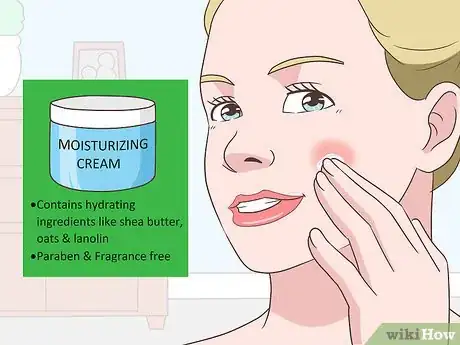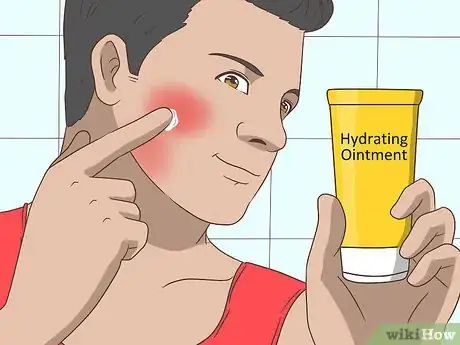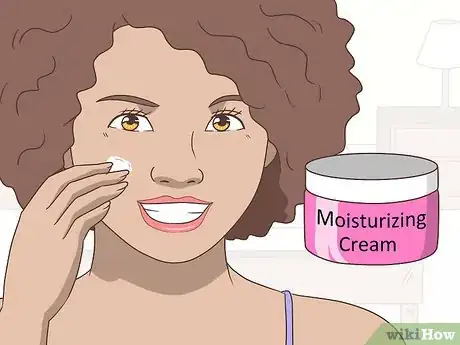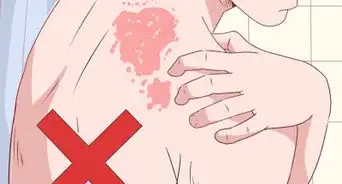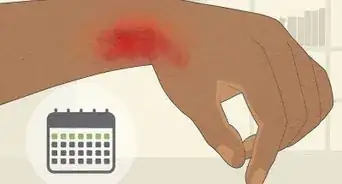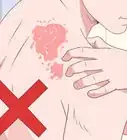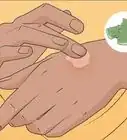This article was co-authored by Mohiba Tareen, MD. Mohiba Tareen is a board certified Dermatologist and the founder of Tareen Dermatology located in Roseville, Maplewood and Faribault, Minnesota. Dr. Tareen completed medical school at the University of Michigan in Ann Arbor, where she was inducted into the prestigious Alpha Omega Alpha honor society. While a dermatology resident at Columbia University in New York City, she won the Conrad Stritzler award of the New York Dermatologic Society and was published in The New England Journal of Medicine. Dr. Tareen then completed a procedural fellowship which focused on dermatologic surgery, laser, and cosmetic dermatology.
This article has been viewed 60,396 times.
After a long day skiing on the slopes or jogging in frigid weather, you may notice you have developed dry, red, swollen skin, also known as wind burn. Wind burn is caused by cold wind and low humidity, leading to cracked, irritated skin that burns. This painful skin condition can be treated by applying moisturizer, gel, or ointment to soothe your skin. You can also care for the wind burn so it heals properly. Make sure you take steps like wearing a face mask or other protective gear to prevent getting wind burn so you can enjoy the great outdoors without having to worry about dry, irritated skin.
Things You Should Know
- Symptoms of windburn are basically identical to sunburn and include red skin, burning sensations, itchiness, and soreness (in fact, many experts believe windburn is just sunburn that occurs in cold weather).
- Moisturize your damaged skin with shea butter, petroleum jelly, aloe vera, or glycerol cream to repair your skin barrier and minimize any pain you experience.
- Stay out of harsh weather, avoid using scented skincare products or soaps, and wear loose-fitting clothing while you’re waiting for your skin to heal.
- If your condition doesn’t improve after 2-3 days of self-treatment, go see a doctor; they may be able to prescribe you a steroid cream that will accelerate how long it takes for the windburn to heal.
Steps
Applying Moisturizer, Gel, or Ointment
-
1Apply a moisturizing cream. Look for a cream that contains hydrating ingredients like shea butter, oats, and lanolin. Make sure the cream is paraben and fragrance-free so it does not irritate your skin.[1]
- Avoid creams with harsh chemicals or dyes, as they can irritate your skin.
-
2Use a hydrating ointment. Ointment is usually thicker than cream and can be a good option if your skin is really irritated or burned.[2]
- It can be especially helpful to apply these ointments overnight. Take care, though, that you do not get any in your eyes.
- Do not look for a triple antibiotic ointment that contains hydrocortisone, unless your skin is broken, infected, and does not seem to be healing. Hydrocortisone usage is good for eczema and treating itch, but will thin your skin out and weaken it, if used more than recommended.[3]
- Brands such as First Aid Beauty, Cetaphil, CeraVe, and Vanicream are well recognized as good for skin healing.
Advertisement -
3
-
4Use coconut oil for a natural option. Coconut oil is great for hydrating and soothing irritated skin. It can also help your skin heal faster. Look for coconut oil at your local health food store or online.[6]
Caring for Wind Burn
-
1Stay indoors and avoid the sun. Try not to go outside and expose your skin to the sun or cold weather. Give your skin time to heal before you venture outside in harsh winds or cold temperatures.
-
2Have lukewarm showers or baths. Very hot showers or baths can dry out your skin further and slow down healing. Opt for lukewarm showers or baths instead so your skin can recover.
-
3Do not rub or scratch at your skin. Doing so can make the wind burn worse. Try not to touch your skin at all, except gently in a shower or bath, so it can heal.[7]
- Wear long sleeve shirts and clothing that covers any areas with wind burn so your skin can recover.
-
4Take over-the-counter pain medication.[8] If you experience pain due to wind burn, have OTC pain medication like ibuprofen or acetaminophen. Follow the dosage instructions on the label and never take more than the recommended amount.
Preventing Wind Burn
-
1
-
2Put on a thick, moisturizing cream to protect your skin. Cover any exposed skin with moisturizing cream to lock in the natural oils in your skin and keep it hydrated. Put lip chap on your lips as well to protect them from wind burn.[11]
- Make sure you reapply the cream as necessary so your skin stays hydrated and protected.
-
3Keep your skin covered when you go outside. Try not to expose your skin to the elements if you can help it. Wear long sleeves and pants as well as gloves, a scarf, and a face covering if you are venturing out into harsh winds or cold weather.[12]
Expert Q&A
-
QuestionHow can I treat wind burn that's on my face?
 Mohiba Tareen, MDMohiba Tareen is a board certified Dermatologist and the founder of Tareen Dermatology located in Roseville, Maplewood and Faribault, Minnesota. Dr. Tareen completed medical school at the University of Michigan in Ann Arbor, where she was inducted into the prestigious Alpha Omega Alpha honor society. While a dermatology resident at Columbia University in New York City, she won the Conrad Stritzler award of the New York Dermatologic Society and was published in The New England Journal of Medicine. Dr. Tareen then completed a procedural fellowship which focused on dermatologic surgery, laser, and cosmetic dermatology.
Mohiba Tareen, MDMohiba Tareen is a board certified Dermatologist and the founder of Tareen Dermatology located in Roseville, Maplewood and Faribault, Minnesota. Dr. Tareen completed medical school at the University of Michigan in Ann Arbor, where she was inducted into the prestigious Alpha Omega Alpha honor society. While a dermatology resident at Columbia University in New York City, she won the Conrad Stritzler award of the New York Dermatologic Society and was published in The New England Journal of Medicine. Dr. Tareen then completed a procedural fellowship which focused on dermatologic surgery, laser, and cosmetic dermatology.
FAAD Board Certified Dermatologist To relieve the burning sensation, rub pure aloe gel into your skin. If your wind burn still hurts, try taking an over-the-counter pain reliever.
To relieve the burning sensation, rub pure aloe gel into your skin. If your wind burn still hurts, try taking an over-the-counter pain reliever.
References
- ↑ http://stylecaster.com/beauty/how-to-treat-prevent-windburn/
- ↑ http://stylecaster.com/beauty/how-to-treat-prevent-windburn/
- ↑ https://www.mayoclinic.org/drugs-supplements/hydrocortisone-topical-application-route/side-effects/drg-20073814
- ↑ Mohiba Tareen, MD. FAAD Board Certified Dermatologist. Expert Interview. 26 March 2020.
- ↑ https://www.angieslist.com/articles/about-windburn-wintry-relative-sunburn.htm
- ↑ http://stylecaster.com/beauty/how-to-treat-prevent-windburn/
- ↑ https://www.canada.ca/en/health-canada/services/healthy-living/your-health/environment/extreme-cold.html
- ↑ Mohiba Tareen, MD. FAAD Board Certified Dermatologist. Expert Interview. 26 March 2020.
- ↑ Mohiba Tareen, MD. FAAD Board Certified Dermatologist. Expert Interview. 26 March 2020.
- ↑ https://www.canada.ca/en/health-canada/services/healthy-living/your-health/environment/extreme-cold.html
- ↑ http://www.nytimes.com/2006/01/05/fashion/thursdaystyles/help-skin-survive-a-cruel-season.html
- ↑ https://www.canada.ca/en/health-canada/services/healthy-living/your-health/environment/extreme-cold.html
